Monthly Updates on Recent Books in the History of Christianity
To raise awareness of recent books in the history of Christianity, the editorial staff of Church History: Studies in Christianity and Culture highlights each month a list of 10-15 books in diverse periods and geographical regions that we hope will be of interest to our members. We include here below the 42nd monthly list, chosen by our staff, with excerpts from the publishers’ blurbs.

Raffaella Perin, The Popes on Air: The History of Vatican Radio from its Origins to World War II. 2024
The book offers the first wide-ranging study on the history of Vatican Radio from its origins (1931) to the end of Pius XII’s pontificate (1958) based on unpublished sources. The opening of the Secret Vatican Archives on the records regarding Pius XII will shed light on the most controversial pontificate of the 20th century. Moreover, the recent rearrangement of the Vatican media provided the creation of a multimedia archive that is still in Fieri.
This research is an original point of view on the most relevant questions concerning these decades: the relation of the Catholic Church with the Fascist regimes and Western democracies; the attitude toward anti-Semitism and the Shoah in Europe, and in general toward the total war; the relationship of the Holy See with the new media in the mass society; the questions arisen in the after-war period such as the Christian Democratic Party in Italy; the new role of women; and anti-communism and the competition for the consensus in the social and moral order in a secularized society.

Stephen Brett Eccher, Zwingli the Pastor: A Life in Conflict. 2024
In Zwingli the Pastor, Stephen Brett Eccher tells the story of Huldrych Zwingli (1484–1531), embattled pastor and reformer. Zwingli’s ministry in Zurich was characterized by conflict—conflict that fueled him. It influenced his theological development, inspired his commitment to bring reform, and compelled his devotion to the congregation he led through the tumult of the Reformation. Eccher reveals a complex Zwingli, whose life and legacy continue to influence Protestantism today.
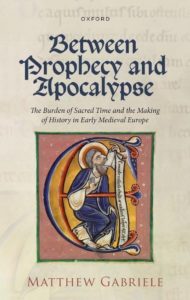
Matthew Gabriele, Between Prophecy and Apocalypse: The Burden of Sacred Time and the Making of History in Early Medieval Europe. 2024
This book maps the movement between two intellectual stances, best described as a shift from prophetic to apocalyptic thinking in medieval Europe. Although the roots of this change lay in late antiquity, the fulcrum of this transition lies in the tenth and eleventh centuries. Biblical commentators in the fourth and fifth centuries enforced a particular understanding of sacred time that held until the ninth century, when exegetes found in their commentaries a different plan for God’s new chosen people. This came into stark relief as the new kingdom of Israel (the Frankish empire under the Carolingians) had splintered in the 840s during the Carolingian civil war. What was perhaps unforeseen was that these commentaries that were written in this specific context would be heavily copied and read for the next 200 years. Ideas that formed in a world that actively lamented the loss of empire had to be translated to a world that could only dream of that empire. As they spread across Europe, these ideas became the basis for monastic educational practices and bled into other types of textual production, such as supposedly “secular” histories. A movement towards surety can be seen in our sources, as in the eleventh century, when medieval Europeans began to try to enact what they thought was God’s plan, often with fire and sword.

Jason Aleksander, Sean Hannan, Joshua Hollmann, and Michael Moore, eds. Mystical Theology and Platonism in the Time of Cusanus: Essays in Honor of Donald F. Duclow. 2023
Mystical Theology and Platonism in the Time of Cusanus engages with the history of mystical theology and Neoplatonic philosophy through the lens of the 15th century philosopher and theologian, Nicholas of Cusa. The volume comprises nineteen essays that break down the barriers between medieval and Renaissance studies, reinterpreting Cusanus’ place in the history of thought by exploring the archive that informed his thinking, while also interrogating his works by exploring them from the standpoint of their later reception by modern philosophers and theologians. The volume also offers tribute to the career of Donald F. Duclow, a leading scholar in the field of Cusanus studies in particular and of the history of mystical theology and Neoplatonic philosophy more generally.
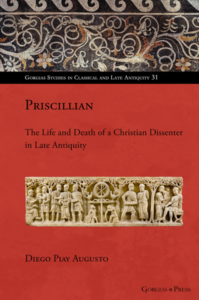
Diego Piay Augusto, Priscillian: The Life and Death of a Christian Dissenter in Late Antiquity. 2024
In this book the author offers us the first historical biography of Priscillian, a controversial figure of great importance for the history of the West, who until now has been considered by the different authors who have approached his figure as a heretic, reformer, apocryphal martyr or non-conformist Christian. The book also analyses the complex questions of his birthplace, the location of his burial place and the dating of the various episodes of his life, using the voices of the protagonists of the period in which Priscillian lived and making use of all the sources available to reconstruct his biography.
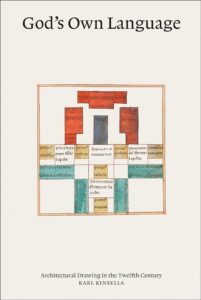
Karl Kinsella, God’s Own Language: Architectural Drawing in the Twelfth Century. 2023
The architectural drawing might seem to be a quintessentially modern form, and indeed many histories of the genre begin in the early modern period with Italian Renaissance architects such as Alberti. Yet the Middle Ages also had a remarkably sophisticated way of drawing and writing about architecture. God's Own Language takes us to twelfth-century Paris, where a Scottish monk named Richard of Saint Victor, along with his mentor Hugh, developed an innovative visual and textual architectural language. In the process, he devised techniques and terms that we still use today, from sectional elevations to the word “plan.”
Surprisingly, however, Richard's detailed drawings appeared not in an architectural treatise but in a widely circulated set of biblical commentaries. Seeing architecture as a way of communicating with the divine, Richard drew plans and elevations for such biblical constructions as Noah's ark and the temple envisioned by the prophet Ezekiel. Interpreting Richard and Hugh's drawings and writings within the context of the thriving theological and intellectual cultures of medieval Paris, Karl Kinsella argues that the popularity of these works suggests that, centuries before the Renaissance, there was a large circle of readers with a highly developed understanding of geometry and the visual language of architecture.

Heather Badamo, Saint George Between Empires: Image and Encounter in the Medieval East. 2023
Pennsylvania State University Press
This volume examines Saint George’s intertwined traditions in the competing states of the eastern Mediterranean and Transcaucasia, demonstrating how rival conceptions of this well-known saint became central to Crusader, Eastern Christian, and Islamic medieval visual cultures.
Saint George Between Empires links the visual cultures of Byzantium, North Africa, the Levant, Syria, and the Caucasus during the Crusader era to redraw our picture of interfaith relations and artistic networks. Badamo recovers and recontextualizes a vast body of images and literature—from etiquette manuals and romances to miracle accounts and chronicles—to describe the history of Saint George during a period of religious and political fragmentation, between his “rise” to cross-cultural prominence in the eleventh century and his “globalization” in the fifteenth. In Badamo’s analysis, George emerges as an exemplar of cross-cultural encounter and global translation.
Featuring important new research on monuments and artworks that are no longer available to scholars as a result of the occupation of Syria and parts of Iraq, Saint George Between Empires will be welcomed by scholars of Byzantine, medieval, Islamic, and Eastern Christian art and cultural studies.
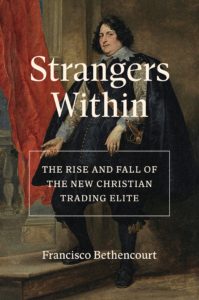
Francisco Bethencourt, Strangers Within: The Rise and Fall of the New Christian Trading Elite. 2024
In Strangers Within, Francisco Bethencourt provides the first comprehensive history of New Christians, the descendants of Jews forced to convert to Catholicism in late medieval Spain and Portugal. Bethencourt estimates that there were around 260,000 New Christians by 1500—more than half of Iberia’s urban population. The majority stayed in Iberia but a significant number moved throughout Europe, Africa, the Middle East, coastal Asia and the New World. They established Sephardic communities in North Africa, the Ottoman Empire, Italy, Amsterdam, Hamburg and London. Bethencourt focuses on the elite of bankers, financiers and merchants from the fifteenth to the eighteenth centuries and the crucial role of this group in global trade and financial services. He analyses their impact on religion (for example, Teresa de Ávila), legal and political thought (Las Casas), science (Amatus Lusitanus), philosophy (Spinoza) and literature (Enríquez Gomez).
Drawing on research in eighteen archives and library manuscript departments in six different countries, Bethencourt argues that the liminal position in which the New Christians found themselves explains their rise, economic prowess and cultural innovation. The New Christians created the first coherent legal case against the discrimination of a minority singled out for systematic judicial inquiry. Cumulative inquisitorial prosecution, coupled with structural changes in international trade, led to their decline and disappearance as a recognizable ethnicity by the mid-eighteenth century. Strangers Within tells an epic story of persecution, resistance and the making of Iberia through the oppression of one of the most powerful minorities in world history.
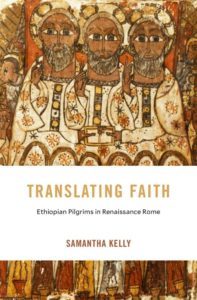
Samantha Kelly, Translating Faith: Ethiopian Pilgrims in Renaissance Rome. 2024
Tucked behind the apse of Saint Peter’s Basilica in Rome is the ancient church of Santo Stefano. During the sixteenth century, Santo Stefano hosted an unusual community: a group of Ethiopian Orthodox pilgrims whose faith and culture were both like and unlike those of Latin Europe. The pilgrims of Santo Stefano were the only African community in premodern Europe to leave extensive documents in their own language (Gǝʿǝz). They also frequently collaborated with Latin Christians to disseminate their expert knowledge of Ethiopia and Ethiopian Christianity, negotiating the era’s heated debates over the boundaries of religious belonging.
Translating Faith is the first book-length study of this community in nearly a century. Drawing on Gǝʿǝz and European-language sources, Samantha Kelly documents how pilgrims maintained Ethiopian Orthodox practices while adapting to a society increasingly committed to Catholic conformity. Focusing especially on the pilgrims’ scholarly collaborations, Kelly shows how they came to produce and share Ethiopian knowledge—as well as how Latin Christian assumptions and priorities transformed that knowledge in unexpected ways. The ambivalent legacies of these exchanges linger today in the European tradition of Ethiopian Studies, which Santo Stefano is credited with founding.
Kelly’s account of the Santo Stefano pilgrim community is a rich tale about the possibilities and pitfalls of ecumenical dialogue, as well as a timely history in our own age marked by intensive and often violent negotiations of religious and racial difference.

Lauren V. Jarvis, A Prophet of the People: Isaiah Shembe and the Making of a South African Church. 2024
Michigan State University Press
In 1910, Isaiah Shembe was struggling. He had left his family and quit his job as a sanitation worker to become a Baptist evangelist, but he ended his first mission without much to show. Little did he know that he would soon establish the Nazaretha Church as he began to attract attention from people left behind by industrial capitalism in South Africa. By his death in 1935, Shembe was an internationally known prophet and healer, described by his peers as “better off than all the Black people.” In A Prophet of the People: Isaiah Shembe and the Making of a South African Church, historian Lauren V. Jarvis provides an intimate portrait of one of South Africa’s most famous religious figures, and in turn the making of modern South Africa. Following Shembe from his birth in the 1860s across many environments and contexts, Jarvis illuminates the tight links between the spread of Christianity, strategies of evasion, and the capacious forms of community that continue to shape South Africa today.
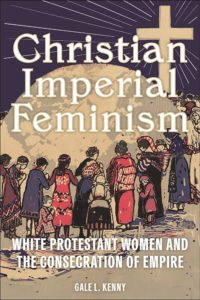
Gale L. Kenny, Christian Imperial Feminism: White Protestant Women and the Consecration of Empire. 2024
Amidst the global instability of the early twentieth century, white Christian American women embraced the idea of an “empire of Christ” that was racially diverse, but which they believed they were uniquely qualified to manage. America’s burgeoning power, combined with women’s rising roles within the church, led to white Protestant women adopting a feminism rooted in religion and imperialism.
Kenny examines this Christian imperial feminism from the women’s missionary movement to create a Christian world order. She shows that this Christian imperial feminism marked a break from an earlier Protestant world view that focused on moral and racial purity and in which interactions among races were inconceivable. This new approach actually prioritized issues like civil rights and racial integration, as well as the uplift of women, though the racially diverse world Christianity it aspired to was still to be rigidly hierarchically ordered, with white women retaining a privileged place as guardians. In exposing these dynamics, this book departs from recent scholarship on white evangelical nationalism to focus on the racial politics of white religious liberalism. Christian Imperial Feminism adds a necessary layer to our understanding of religion, gender, and empire.
Finally, for staying up-to-date on the latest titles in all fields, we recommend regularly perusing New Books Network and its "New Books in Christian Studies” page. These pages are updated regularly.
